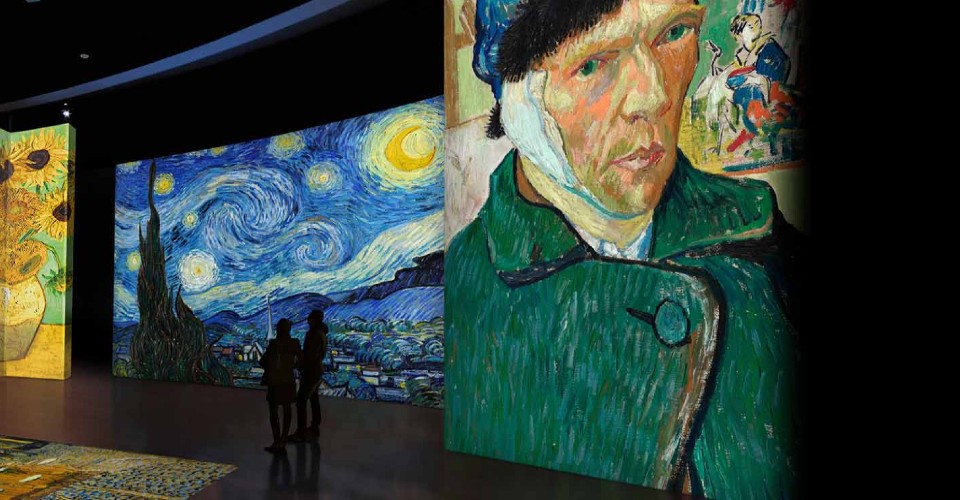The Grand Pavillion, 88 North Tce, North Adelaide, Fri 2 Jul.
by Ian Bell.
Art is amazing! Somebody is driven create a thing, then they do the thing over and over, and they get better and better at the thing, and sometimes they get so good at doing the thing that other people recognize they have achieved a level of skill or accomplishment at the thing. Sometimes those people become rich and famous, they are revered, rewarded, fawned over and showered with praise and wealth and status.
But then you have Vincent Van Gogh who is arguably the greatest post-Impressionist painter of all time; his works are utterly beautiful, evocative, filled with ecstatic joy and inspiration. For generations he has been celebrated rightly as a master of his and all art. Yet during his life he sold one work, and spent his time frantically painting and drawing and battling poor mental and physical health issues that lead to a miserable existence; his life almost the template for the story of the suffering artist.
Born in 1853 in a small agricultural town in the Netherlands to upper middle-class parents, Vincent left school at age 16 and worked in an art house with an uncle and was exposed to many different styles and artists, which gave him an idea about what kind of value art might have. Even at a young age Vincent suffered depression and psychotic episodes Van Gogh did not take up art until he was 27 years old with the next ten years being prolific, producing 930 paintings and 1,100 drawings and sketches (an average of two every day). After ten years of frantic art, poor health and mental issues Vincent Van Gogh committed suicide in 1890 he was just 37 years old. His brother who had supported him financially was convinced his sibling’s art was to be of significance and worked tirelessly to bring Vincent’s art to the world. These days an original piece sells for millions of dollars and in 1990 his Portrait Of Doctor Gachet sold for a staggering US$82.5m.
As part of the Illuminate Adelaide festival Van Gogh Alive: The Experience has found a home in a purpose built 25,000 square foot venue The Grand Pavilion at 88 O’Connell St, North Adelaide (the old Le Cornu’s site). The build has been going on for months and the result is an amazing venue for this stunning and unique art experience. From the moment you enter the building, you are immersed in the sights and colours of Vincent’s world. From the café, to the souvenir shop, to the eternal sunflower room, you are stepping into van Gogh paintings almost literally.
The main exhibition area is a huge, darkened room with dozens of screens – some as high as six meters tall, and the work is projected everywhere. On the floor, wall level, up above doors. The images of van Gogh’s life and work literally come alive, with close details, portraits and landscapes being digitally animated. The Starry Night skies swirls and clouds move across the skyline, crows take flight, trains chug along tracks, a painting of a harbour has reflected light that glistens on the rippling water. Many of the original versions of these works are on small canvas’s but here, seeing these masterful works projected six meters high, you can gaze in awe at the minutia of every brush stroke, every tiny detail, every thread of emotion in the faces the exacting detail of each field, flower and cloud.
Multiple screens are simultaneously showing different images or sometimes detail of something on another screen. The narrative comes mostly from Vincent’s own letters (he was a prolific writer) and shows he knew he was doing something extraordinary, but that he was almost certainly not going to see success in his own lifetime. Unlike other art exhibitions, which are generally static and don’t have a tangible human arc to their story, Van Gogh Alive, is soaked in his story – his tragically short life, the depths of pain and despair and the beauty and the explosive transformative joy that he somehow expressed in his art.
The moving images are projected from forty hidden points and are accompanied by an evocative selection of classical music from Vivaldi, Bach, Schubert, Liszt, Handel and others.
One cannot help but think of the Doctor Who episode Vincent in which Matt Smith’s eleventh incarnation of the Timelord, scoops up Vincent and takes him to visit an art gallery in 2010. Written by Richard Curtis that scene is perhaps one of the greatest scenes in cinematic history. Vincent walking into the Van Gogh exhibition and seeing his work revered and adored; a fictional respite in his tortured life. The gallery curator (beautifully played by the great Bill Nighy) is asked where Van Gogh rates in the history of art. The reply is achingly beautiful and never fails to make me tear up:
“Well… um… big question, but, to me Van Gogh is the finest painter of them all. Certainly, the most popular, great painter of all time. The most beloved, his command of colour most magnificent. He transformed the pain of his tormented life into ecstatic beauty. Pain is easy to portray, but to use your passion and pain to portray the ecstasy and joy and magnificence of our world, no one had ever done it before. Perhaps no one ever will again. To my mind, that strange, wild man who roamed the fields of Provence was not only the world’s greatest artist, but also one of the greatest men who ever lived.”
Immerse yourself in that ecstasy, joy and magnificence of Vincent’s world.
5 stars
Ian Bell
Van Gogh Alive: The Experience continues at The Grand Pavilion, 88 North Tce, North Adelaide, at 30 minute intervals throughout the day, until Sun 1 Aug.
Book at Ticketek and <vangoghalive.com.au>. Click HERE to purchase your tickets.

The Clothesline Rating...
Ian Bell
Ecstasy, joy and magnificence.




